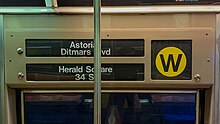R68 (New York City Subway car)
The R68's manufacturers suffered from significant system integration problems, and the fleet became known as a "lemon" in its early years, but its performance was improved following modifications by the New York City Transit Authority.
Like the R44s and R46s, which are also 75 feet (22.86 m) long, they are prohibited from running on the BMT Eastern Division lines (J, L, M & Z trains) because of tight curves.
This order was evolved from the R55,[5] a proposed car that was considered in the early 1980s, but never left the drawing board, or purchased due to a lack of funding.
The R68s on the shuttle remain as single units with OPTO switches added, while the rest of the fleet were reconfigured into sets of four.
[6] The delivery of the first R68 was made on February 4, 1986, but it failed to pass a sharp curve on the South Brooklyn Railway trackage on 38th Street in Brooklyn, and as a result, the curve had to be rebuilt and the radius eased somewhat, and the delivery took place on February 26, 1986.
The R68s' first entry to revenue service was on June 20, 1986, on the Brooklyn half of the divided D train with the first fleet consisting of cars 2500–2507.
Poor communication and coordination between the car body builder (ANF Industrie) and the chassis assembler (Westinghouse) led to operational failures.
[13] Extensive work performed by the New York City Transit Authority provided solutions to the fleet's many problems.
[10] In 2010, the MTA proposed mid-life technological upgrades for the R68s, including LED destination signs and automated announcements.
Each program gave out the date and time, and all retrofitted cars ran on the G.[16] However, none of the displays indicated the next stops along the routes.
The entire consist was pulled from service on April 22, 2021, due to concerns over Suzhou Huaqi's ties to the Chinese government.

